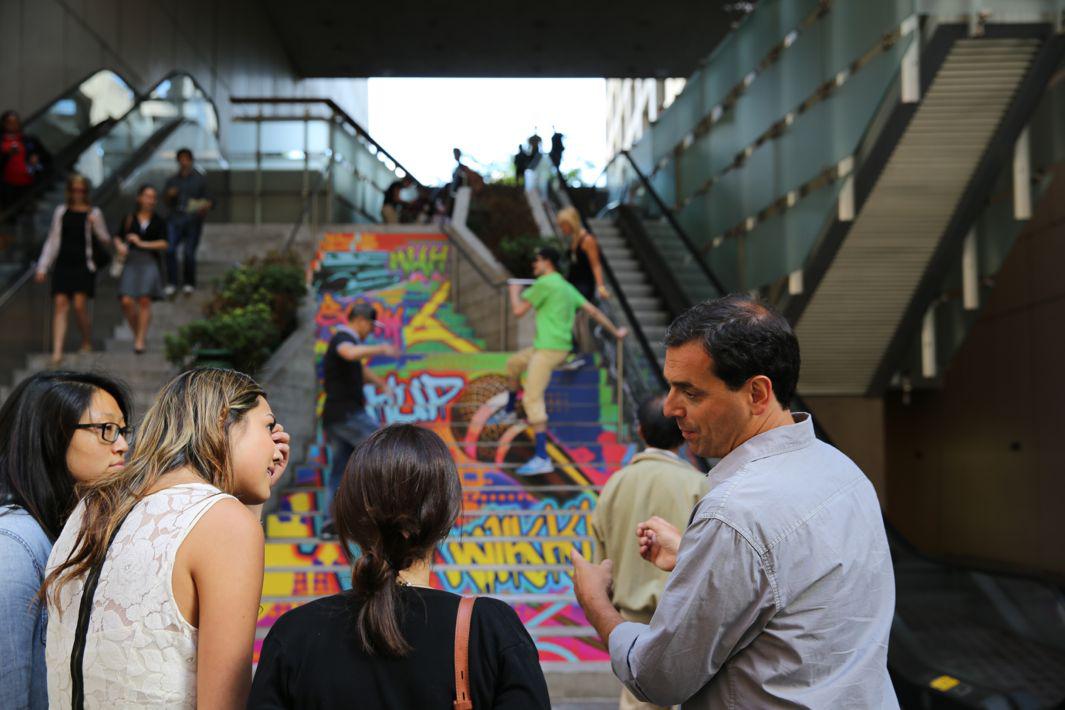Can design help solve social problems across America? Crowd Control—a new TV series hosted by best-selling author and popular speaker Dan Pink—features more than 40 experiments across the country that use low-cost, high-impact design, technology, and behavioral science principles to try to solve a host of issues big and small.
For the series, premiering Nov. 24 on the National Geographic Channel, Pink says that he and his team made a giant list of social problems: Why people don’t give up their seats on public transport for pregnant women or use recycling bins in public parks? Why do they jaywalk and drive too fast and park in handicapped spaces? They looked for science on what might cause the annoying, unhealthy, or antisocial behaviors. Then they looked to design and technology to build surprising solutions.

Courtesy of National Geographic Channel
To tackle the issue of speeding, they offered rewards for obeying the law. Pink and his team rigged a stretch of Route 66 in New Mexico to play “America the Beautiful” when people drove the speed limit. They copied a Swedish initiative that recorded people driving at or just under the speed limit, offering those who entered into a speed camera sweepstakes the chance to win $100. They attempted to thwart jaywalking at an intersection by hanging talking street signs (“Your wife will forgive you for being late. But she can’t forgive you if you’re dead. Don’t jaywalk.”) and by installing a video game that occupied waiting pedestrians with a virtual tug-of-war until the light turned green.
Not every experiment worked. In one episode, Pink attempts to mimic a scheme in India in which local authorities planted life-size cardboard cutouts of trompe l’oeil police officers like scarecrows in crowded urban areas to deter bike thieves. Pink thought the same trick might work in New Orleans. He found an actor with an intimidating face (based, he said, on science that indicates men with higher width-to-height face ratios can be more prone to aggression), put him in a police uniform, photographed him, and commissioned a mini force of cardboard cutout police. “I was totally pumped by the research,” Pink told me in a phone interview. “I thought, ‘This will be a really cool, low-cost solution.’ It did deter the bike thefts. But people stole the cutouts.”
Another challenge came when the Crowd Control team tried to encourage people to take the stairs instead of an adjacent escalator in Lower Manhattan. First they planted signs that showed a typically skinny stick figure pointing toward the stairs and a fattened one pointing to the escalator.
“It was a total failure,” Pink says. “People ignored it. They were on autopilot and just took the escalator. And some people told me they were offended by the fat stick figure.”

Courtesy of National Geographic Channel
So they tried another approach, transforming the stairs into a giant beatbox machine that surprised and compelled people to walk—or dance—up and down the stairs to see what sort of sounds they could make with their feet. In effect he had tricked people into unwittingly doing something good for their health by amusing them—and with no mention of exercise whatsoever.
To stop able-bodied drivers from using handicapped parking places in Austin, Texas, Pink first rode around with a van full of local activists, blocking in offenders and making them wait while passengers in wheelchairs got out very slowly. A woman with an SUV apologized; a guy with a Porsche said, “I don’t do this; it’s not a habit,” lamely offering that he was just stopping in to see some friends for a 10-minute drink. “Now I’m that guy, and it doesn’t feel good,” he said, adding perhaps a little too easily: “I’m done being that guy.” But you could see that the human confrontation had somehow registered.

Courtesy of National Geographic Channel
Pink wondered if there was a more practical way to stir up empathy, so he tried to deter potential violators with human faces to remind them that parking in handicapped spaces isn’t a victimless crime. Below the conventional blue-and-white handicapped parking signs he placed signs that pictured wheelchair-using locals with the words: “Think of Me. Keep it Free.” A hidden camera trained on the spots for a month showed several people pulling into spots, hesitating, then pulling out. Pink got some of the near-offenders to talk about the effects of the signs on their behavior in the sneak peek below:
Pink says that although the camera recorded no handicapped parking violations during the month that they had it installed, the results aren’t scientific: “We can’t do random, double-blind controlled experiments.” The idea of the show is to offer a thought-provoking, entertaining look at imaginative, practical, low-cost solutions that could be implemented elsewhere. “We didn’t have a really huge design budget,” Pink says. “This is cable television. But we wanted to find solutions that would foster creativity, to show that you can do more with less.”
